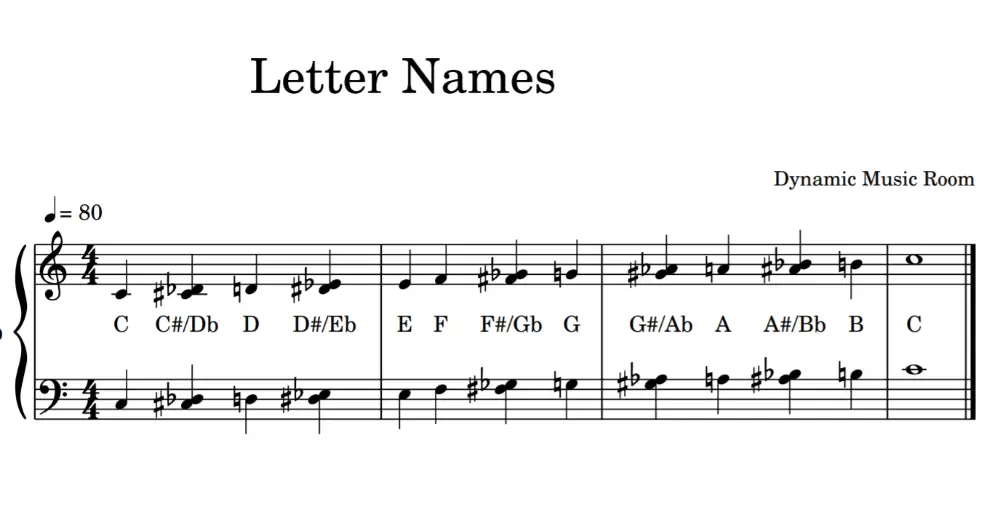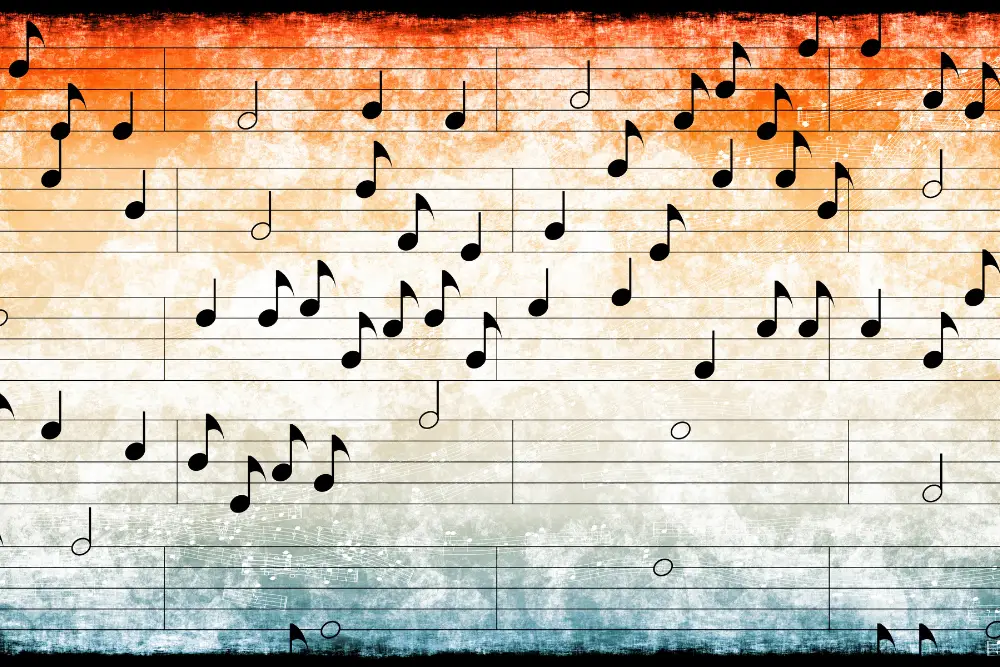Are you looking for more explanation on the solfege to letter equivalents?
Do you want easy reference tables to help you out?
One of the best parts of solfege is how it helps you learn to sing and play in any key, but until you learn this skill well, it’s a tricky idea to connect solfege notes on the staff.
We’re here to help you with this guide on solfege to notes.
Translating solfege to notes isn’t hard to do. Look for the starting pitch in each major key and assign them solfege pitches according to the solfege scale starting with Do. For minor keys, start on La instead of Do.
Learn more details and check out the easy-reference tables below.
Table of Contents
Solfege Vs. Letter Names
In this section, we’ll briefly go over what solfege notation is, what letter names are, and the pros and cons of each.
Solfege Notation
Solfege is when you assign scale degrees to syllables invented hundreds of years ago.
Using the same syllables across different keys allows you to develop better inner hearing and understanding of how the notes are related to one another and function in keys.
For singers, solfege is an essential skill, helping many realize how to sing at sight without hearing it first.
Learn more about how solfege works.
Pros Of Solfege
Here are some of the most significant benefits of solfege:
- Helps you recognize recurring patterns in music
- Develops your inner hearing skills
- Assists in writing down the music you hear
- Improves your ability to sing and play in tune
- Gives an “instinct” in music which leads to better performance, composition, and improvisation
Cons Of Solfege
There aren’t any significant drawbacks to solfege, but here are some reasons people don’t use it:
- Takes time to convert pitches into solfege names at first
- Words may seem disconnected and nonsense to some
- Instrumentalists may not need them as much (though I’d disagree with this!)
Check out the purpose of solfege hand signs.
Letter Names / Staff Notes
The letter names are assigned letters given to specific pitches on the staff.
Regardless of the key, these notes stay the same.
This was a critical standardization hundreds of years ago and allowed people from all over the world to play together and sound good.
The letter names are defined by letters and numbers.
The letters start on A and go through G.
Once you reach G, it’s repeated back through A again.
The numbers tell us the octave the letter is in.
For example, the C in the middle of a piano is called C4.
The next time C appears higher; it’s called C5.
When it appears lower, it’s called C5.
Check out this image for the letter names on the staff.

Note: For this article, we won’t focus on the number part of the solfege to notes translation.
Pros For Letter Names
- Tells instruments what to play exactly
- Helps everyone play on the same notes
- Most people who read music use this first
Cons For Letter Names
- Isn’t as useful for singers right away
- Doesn’t help you to learn to change keys easily
- Requires fluent reading abilities in different ways
Solfege To Note Names
Turning letter names to solfege doesn’t have to be hard.
It just takes time and practice.
In this section, we’ll talk about the process of converting notes to solfege and give useful reference images in all major and minor keys.
The Process Of Converting Solfege To Note Names
The process is broken into 2 main methods: Major and Minor.
Major Conversion
Look at the key the piece or song is in.
The scale degrees are given numbers 1-8.
1 and 8 are the same, just an octave or 8 steps apart.
Each number is given a solfege pitch.
| Scale Degree | Solfege Syllable |
| 1 | Do |
| 2 | Re |
| 3 | Mi |
| 4 | Fa |
| 5 | Sol |
| 6 | La |
| 7 | Ti |
| 8 | Do |
Minor Conversation
There’s some debate on the best way to convert minor keys.
One method starts on Do and uses a lot of chromatic solfege.
In my opinion, this method isn’t helpful.
The other method starts on La.
By starting on La (which is the relationship between major and minor anyway), we avoid almost all altered solfege.
| Scale Degree | Solfege Syllable |
| 1 | La |
| 2 | Ti |
| 3 | Do |
| 4 | Re |
| 5 | Mi |
| 6 | Fa |
| 7 | Sol |
| 8 | La |
Solfege To Notes, Key By Key
Check out these images for the solfege to notes, key by key.
Major and the relative minor keys are combined in each section.
C Major / A Minor
For these keys, we’ll be looking at the base conversion where C = Do and A = La.
From there, it’s simple.
Check out the graphic.
| Letter Name | Solfege Syllable |
| C | Do |
| D | Re |
| E | Mi |
| F | Fa |
| G | Sol |
| A | La |
| B | Ti |
| C | Do |
G Major / E Minor
For these keys, we’ll be looking at the base conversion where G = Do and E = La.
From there, it’s simple.
Check out the graphic.
| Letter Name | Solfege Syllable |
| G | Do |
| A | Re |
| B | Mi |
| C | Fa |
| D | Sol |
| E | La |
| F# | Ti |
| G | Do |
D Major / B Minor
For these keys, we’ll be looking at the base conversion where D = Do and B = La.
From there, it’s simple.
Check out the graphic.
| Letter Name | Solfege Syllable |
| D | Do |
| E | Re |
| F# | Mi |
| G | Fa |
| A | Sol |
| B | La |
| C# | Ti |
| D | Do |
A Major / F# Minor
For these keys, we’ll be looking at the base conversion where A = Do and F# = La.
From there, it’s simple.
Check out the graphic.
| Letter Name | Solfege Syllable |
| A | Do |
| B | Re |
| C# | Mi |
| D | Fa |
| E | Sol |
| F# | La |
| G# | Ti |
| A | Do |
E Major / C# Minor
For these keys, we’ll be looking at the base conversion where E = Do and C# = La.
From there, it’s simple.
Check out the graphic.
| Letter Name | Solfege Syllable |
| E | Do |
| F# | Re |
| G# | Mi |
| A | Fa |
| B | Sol |
| C# | La |
| D# | Ti |
| E | Do |
B Major / G# Minor
For these keys, we’ll be looking at the base conversion where B = Do and G# = La.
From there, it’s simple.
Check out the graphic.
| Letter Name | Solfege Syllable |
| B | Do |
| C# | Re |
| D# | Mi |
| E | Fa |
| F# | Sol |
| G# | La |
| A# | Ti |
| B | Do |
F# Major / D# Minor (Gb Major / Eb Minor)
For these keys, we’ll be looking at the base conversion where F#/Gb = Do and D#/Eb = La.
From there, it’s simple.
Check out the graphic.
| Letter Name | Solfege Syllable |
| F#/Gb | Do |
| G#/Ab | Re |
| A#/Bb | Mi |
| B/Cb | Fa |
| C#/Db | Sol |
| D#/Eb | La |
| E#/F | Ti |
| F#/Gb | Do |
Db Major / Bb Minor
For these keys, we’ll be looking at the base conversion where Db = Do and Bb = La.
From there, it’s simple.
Check out the graphic.
| Letter Name | Solfege Syllable |
| Db | Do |
| Eb | Re |
| F | Mi |
| Gb | Fa |
| Ab | Sol |
| Bb | La |
| C | Ti |
| Db | Do |
Ab Major / F Minor
For these keys, we’ll be looking at the base conversion where Ab = Do and F = La.
From there, it’s simple.
Check out the graphic.
| Letter Name | Solfege Syllable |
| Ab | Do |
| Bb | Re |
| C | Mi |
| Db | Fa |
| Eb | Sol |
| F | La |
| G | Ti |
| Ab | Do |
Eb Major / C Minor
For these keys, we’ll be looking at the base conversion where Eb = Do and C = La.
From there, it’s simple.
Check out the graphic.
| Letter Name | Solfege Syllable |
| Eb | Do |
| F | Re |
| G | Mi |
| Ab | Fa |
| Bb | Sol |
| C | La |
| D | Ti |
| Eb | Do |
Bb Major / G Minor
For these keys, we’ll be looking at the base conversion where Bb = Do and G = La.
From there, it’s simple.
Check out the graphic.
| Letter Name | Solfege Syllable |
| Bb | Do |
| C | Re |
| D | Mi |
| Eb | Fa |
| F | Sol |
| G | La |
| A | Ti |
| Bb | Do |
F Major / D Minor
For these keys, we’ll be looking at the base conversion where F = Do and D = La.
From there, it’s simple.
Check out the graphic.
| Letter Name | Solfege Syllable |
| F | Do |
| G | Re |
| A | Mi |
| Bb | Fa |
| C | Sol |
| D | La |
| E | Ti |
| F | Do |
Final Thoughts
I hope the solfege to notes translation helps you on your solfege journey.
With practice, it’ll come.
Just take it one step at a time.
You may also want to check out these 11 music lessons plans for elementary.

